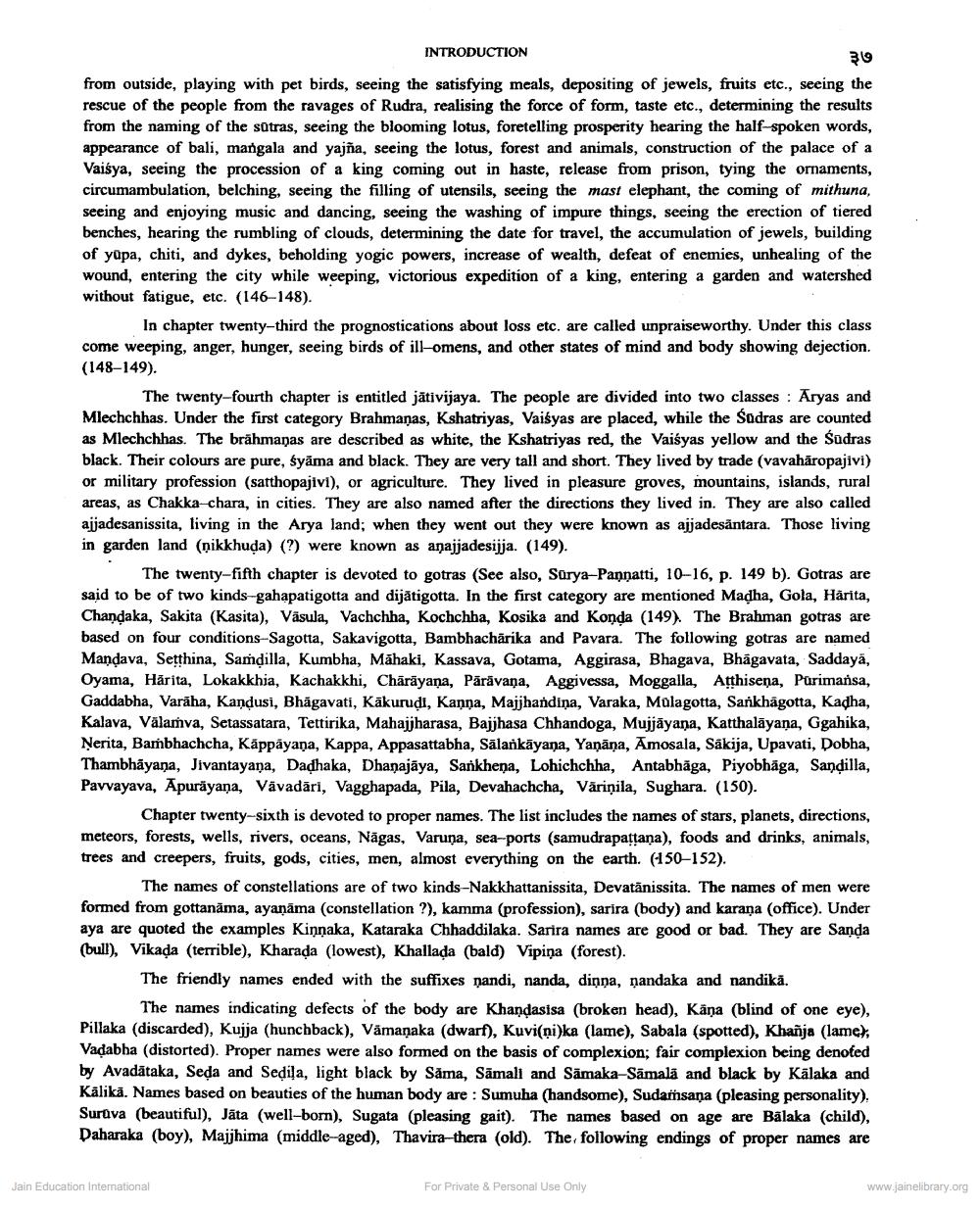________________
INTRODUCTION
३७ from outside, playing with pet birds, seeing the satisfying meals, depositing of jewels, fruits etc., seeing the rescue of the people from the ravages of Rudra, realising the force of form, taste etc., determining the results from the naming of the sotras, seeing the blooming lotus, foretelling prosperity hearing the half-spoken words, appearance of bali, mangala and yajña, seeing the lotus, forest and animals, construction of the palace of a Vaisya, seeing the procession of a king coming out in haste, release from prison, tying the ornaments, circumambulation, belching, seeing the filling of utensils, seeing the mast elephant, the coming of mithuna, seeing and enjoying music and dancing, seeing the washing of impure things, seeing the erection of tiered benches, hearing the rumbling of clouds, determining the date for travel, the accumulation of jewels, building of yūpa, chiti, and dykes, beholding yogic powers, increase of wealth, defeat of enemies, unhealing of the wound, entering the city while weeping, victorious expedition of a king, entering a garden and watershed without fatigue, etc. (146–148).
In chapter twenty-third the prognostications about loss etc. are called unpraiseworthy. Under this class come weeping, anger, hunger, seeing birds of ill-omens, and other states of mind and body showing dejection. (148–149).
The twenty-fourth chapter is entitled jātivijaya. The people are divided into two classes : Aryas and Mlechchhas. Under the first category Brahmanas, Kshatriyas, Vaisyas are placed, while the Sudras are counted as Mlechchhas. The brāhmaṇas are described as white, the Kshatriyas red, the Vaiśyas yellow and the Sudras black. Their colours are pure, śyāma and black. They are very tall and short. They lived by trade (vavahāropajivi) or military profession (satthopajivi), or agriculture. They lived in pleasure groves, mountains, islands, rural areas, as Chakka chara, in cities. They are also named after the directions they lived in. They are also called ajjadesanissita, living in the Arya land; when they went out they were known as ajjadesäntara. Those living in garden land (ņikkhuda) (?) were known as anajjadesijja. (149).
The twenty-fifth chapter is devoted to gotras (See also, Sürya-Pannatti, 10-16, p. 149 b). Gotras are said to be of two kinds-gahapatigotta and dijātigotta. In the first category are mentioned Madha, Gola, Harita, Chandaka, Sakita (Kasita), Väsula, Vachchha, Kochchha, Kosika and Konda (149) The Brahman gotras are based on four conditions Sagotta, Sakavigotta, Bambhachărika and Pavara. The following gotras are named Mandava, Setthina, Samdilla, Kumbha, Māhaki, Kassava, Gotama, Aggirasa, Bhagava, Bhagavata, Saddaya, Oyama, Härita, Lokakkhia, Kachakkhi, Chäräyana, Pārāvana, Aggivessa, Moggalla, Atthisena, Purimansa, Gaddabha, Varāha, Kandusi, Bhagavati, Kākurudi, Kaņņa, Majjhandiņa, Varaka, Mulagotta, Sarkhāgotta, Kadha, Kalava, Välamva, Setassatara, Tettirika, Mahajjharasa, Bajjhasa Chhandoga, Mujjāyana, Katthalāyana, Ggahika, Ņerita, Bambhachcha, Käppäyana, Kappa, Appasattabha, Sālankāyana, Yaņāna, Amosala, Sakija, Upavati, Dobha, Thambhāyana, Jivantayana, Dadhaka, Dhanajāya, Sankhena, Lohichchha, Antabhāga, Piyobhāga, Sandilla, Pavvayava, Apurayaņa, Vävadāri, Vagghapada, Pila, Devahachcha, Väriņila, Sughara. (150).
Chapter twenty-sixth is devoted to proper names. The list includes the names of stars, planets, directions, meteors, forests, wells, rivers, oceans, Nāgas, Varuna, sea-ports (samudrapattana), foods and drinks, animals, trees and creepers, fruits, gods, cities, men, almost everything on the earth. (150–152).
The names of constellations are of two kinds-Nakkhattanissita, Devatānissita. The names of men were formed from gottanāma, ayaņāma (constellation ?), kamma (profession), sarira (body) and karana (office). Under aya are quoted the examples Kinnaka, Kataraka Chhaddilaka. Sarira names are good or bad. They are Sanda (bull), Vikada (terrible), Kharada (lowest), Khallada (bald) Vipiņa (forest).
The friendly names ended with the suffixes nandi, nanda, dinna, nandaka and nandikā.
The names indicating defects of the body are Khandasisa (broken head), Käna (blind of one eye), Pillaka (discarded), Kujja (hunchback), Vamanaka (dwarf), Kuvi(ni)ka (lame), Sabala (spotted), Khanja (lame), Vadabha (distorted). Proper names were also formed on the basis of complexion; fair complexion being denoted by Avadātaka, Seda and Sediļa, light black by Säma, Sāmall and Sämaka-Sámalā and black by Kalaka and Kālikā. Names based on beauties of the human body are : Sumuha (handsome), Sudarsana (pleasing personality), Suruva (beautiful), Jāta (well-born), Sugata (pleasing gait). The names based on age are Balaka (child), Daharaka (boy), Majjhima (middle-aged), Thavira-thera (old). The following endings of proper names are
Jain Education International
For Private & Personal Use Only
www.jainelibrary.org




